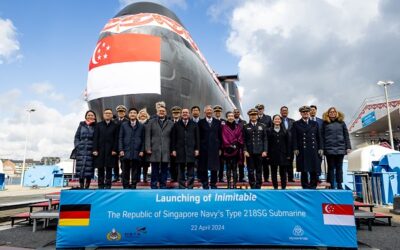National Will Driving Accelerated Development, Test and Fielding
As Russia and China continue to develop capable hypersonic weapons, the US has identified the domain one of the highest priority areas for modernisation. Hypersonic weapons travel at speeds above Mach 5, typically at altitudes of 80-200,000ft, and manoeuvre in unpredictable ways, making defence against them more difficult.
Speaking to the Air Force Association Aerospace Warfare Symposium, Mike White, Principal Director for Hypersonics in the Office of the Undersecretary of Defense for Research and Engineering, explained the high operating altitude creates a capability gap between air and ballistic missile defences. To address these challenges, DoD has developed a hypersonics modernisation strategy that accelerates development and delivery of transformational capabilities, consisting of:
- Developing air-, land-, and sea-launched, conventionally-armed hypersonic strike weapons for highly-survivable, long-range, time-critical defeat of maritime, coastal and inland targets of critical importance;
- Using comprehensive, layered defeat of an adversary’s tactical hypersonic strike missile capability;
- Using reusable hypersonic systems for ISR and strike, as well as the first stage of a two-stage vehicle for rapid access to space.
White said DoD’s strategy has four major phases of implementation:
- Phase 1 – technology development and concept demonstration;
- Phase 2 – weapon system concept prototype development and demonstration;
- Phase 3 – accelerated fielding of prototype weapon system capability;
- Phase 4 – creation of acquisition programmes and capability phasing plans.
The strategy is being implemented in a coordinated set of interservice programmes, accompanied by critical enabling investments in the industrial base and organic laboratories, as well as working collaboratively with allies, where appropriate. “We will deliver strike capability to the warfighter in the early-mid 2020s and a layered hypersonic defense capability — first terminal and then glide phase — in the mid-late 2020s. For reusable systems, our goal is to deliver capability in the early to mid-2030s,” he explained.
Brig Gen Heath A Collins, PEO Weapons and Director of the Armament Directorate at the Air Force Life Cycle Management Center, said his organisation is developing a rapid prototyping programme for the AGM-183A boost=glide-based air-launched rapid response weapon (ARRW). Stating his team is preparing for the first booster flight test next week, he added “We’re also getting ready to transition into production within about a year on that program, so it will be the first air-launch hypersonic weapon that the Air Force has […] we’re just on the cusp of an operational capability.”
James Weber, senior scientist for hypersonics at the Air Force Research Laboratory, said the lab has a long history in hypersonic science and technology development, beginning in the early 1960s, adding that, over the last 25 years, DoD has invested some $1.7 billion (€1.4 billion) in hypersonics. “We have a wide technology portfolio for hypersonics with competencies in test capabilities and thermal propulsion — such as scramjet propulsion and solid rocket motors and liquid rockets, materials, high-temperature materials and structures, manufacturing, guidance control systems and also basic research.”
For instance, Weber said AFRL is partnering with DARPA on the hypersonic, air-breathing weapon concept programme, as well as the tactical boost glider programmes. “We are partnered with them to develop and demonstrate critical technologies for launch of hypersonic weapons by FY22.” He further added the laboratory is also collaborating on ARRW.
Maj Gen Andrew J Gebara, Director of Strategic Plans, Programs and Requirements at Air Force Global Strike Command, said that developing new hypersonic capabilities requires accelerated acquisition strategies, once the most promising programmes have been identified. Previous excellent testing work has not followed through to production, he explained. What appears to be different now is the existence of a national will to accelerate the programmes and get them fielded rapidly.

























